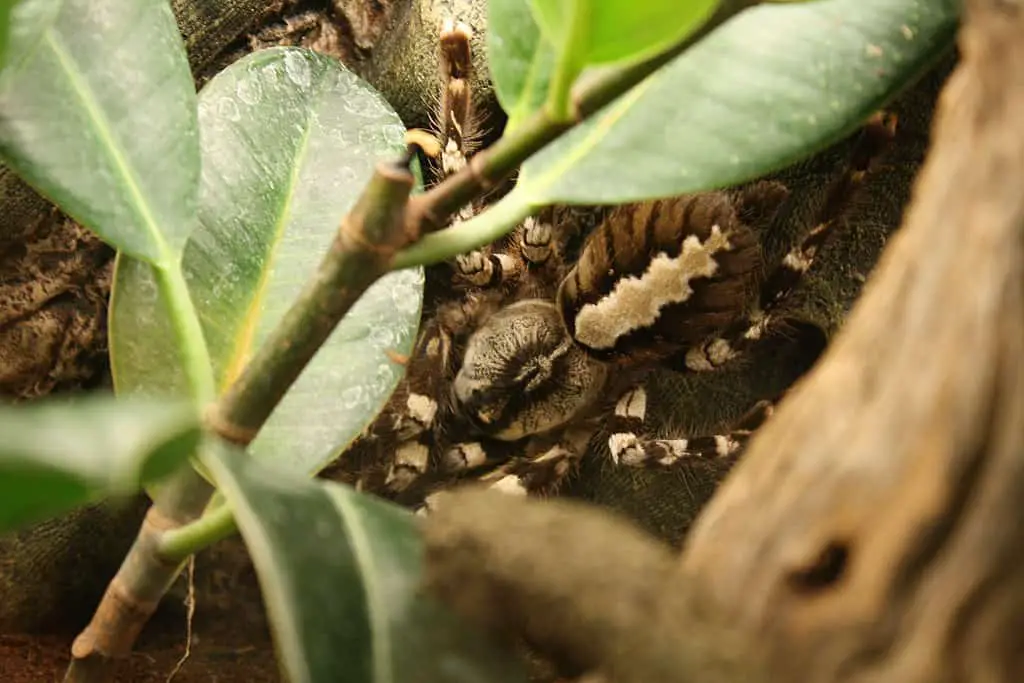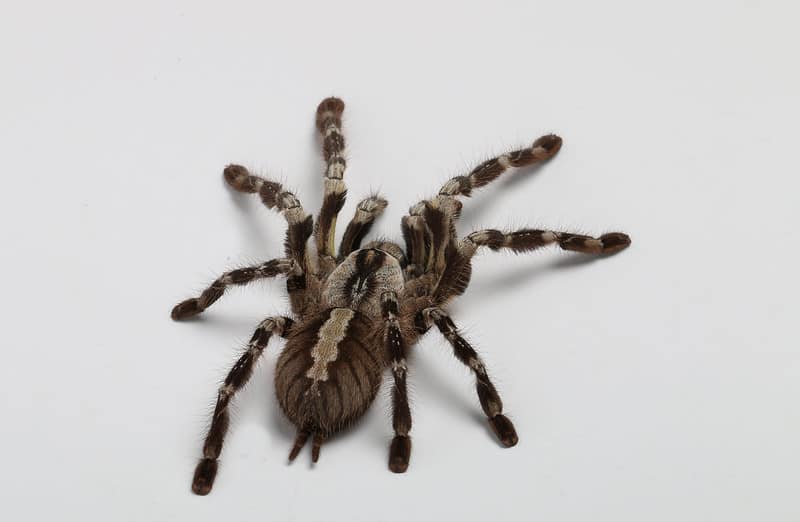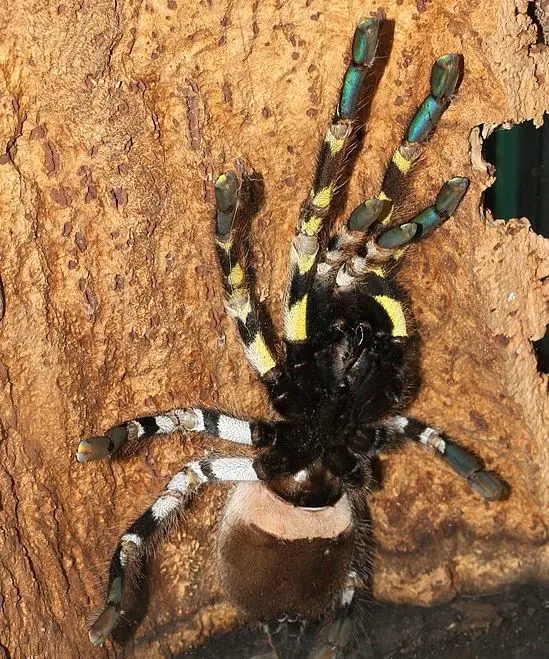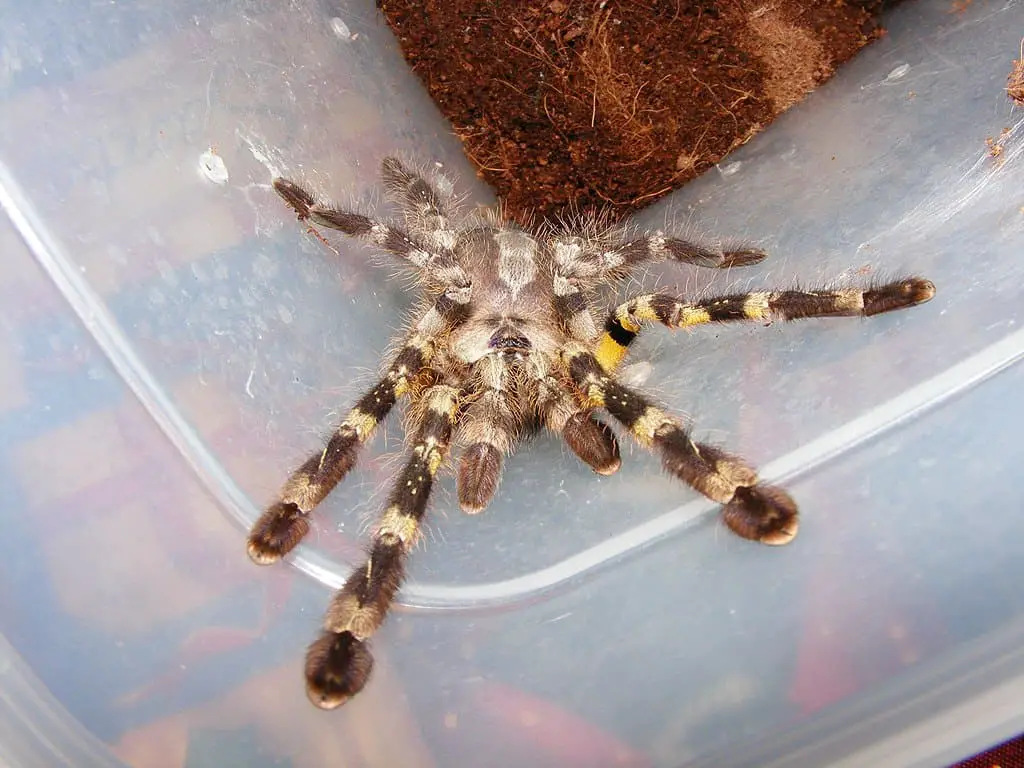The Indian Ornamental Tarantula (Poecilotheria Regalis) is an Old World tarantula species. As the name suggests, this species is native to India. It’s an arboreal spider that spends the majority of its life in the trees. It’s most well known for its unique coloration and pattern, making it highly desired as a display tarantula.
If you’re considering adding the P. Regalis to your collection there are some things you need to know first. Keep reading, and you’ll know everything you need to know about this species in no time!

Indian Ornamental Tarantula Care Sheet
| Species Name | Poecilotheria Regalis |
| Family Name | Theraphosidae |
| Common Name | Indian Ornamental Tarantula |
| Category | Old World |
| Type | Arboreal |
| Native Location | India |
| Body Length | 2.5 to 3 inches |
| Leg Span | 7 to 7.5 inches |
| Growth Speed | Fast |
| Urticating Hairs | No |
| Social | Typically solitary, communal living might be possible |
| Diet | Insects: crickets, roaches, mealworms, etc |
| Temperature | 75 to 80 Fahrenheit |
| Humidity | 75 to 80% |
| Life Expectancy | Females, 11 to 15 years. Males, 3 years |
| Recommended Experience Level | Advanced |
| Minimum tank size | 8″x8″x20″ |
Indian Ornamental Tarantula overview

The Indian Ornamental Tarantula is an arboreal spider that’s native to the Eastern Ghats, a mountain range in India. It was first described in 1899 and is known for its large size and beautiful appearance. In the wild, they live in holes in the trees where they create funnel webs.
This species has strong fangs and quite a potent venom that can cause extreme pain. Since they’re an Old World species they do not have urticating hairs.
They live in the trees, and in the wild, they primarily feed on flying insects.
Appearance & Varieties
The Indian Ornamental Tarantula is very large and can grow to a size of over 7 inches. To complement their large size, they have massive, venomous fangs.
Not only is this spider large, but it’s also very beautiful. It has a black and white body and abdomen as well as black legs with white bands. In addition, it has yellow spots on the bottom of the legs. When the spider takes on a threat posture this yellow coloration becomes clearly visible giving any potential a clear warning sign not to come too close.
Its large size combined with its beautiful appearance makes this species an excellent show spider. To make it even better, they tend to sit out in the open quite often which gives owners a good chance to admire them.
As is standard with tarantulas, males are quite a bit smaller than females.
Price
Indian Ornamental Tarantulas are not the most expensive species out there. The fact that they’re not endangered and have been part of the hobby for a long time makes them widely available from breeders and pet shops.
On average, the price for one of these spiders typically ranges between $65 and $200. Slings and males are on the cheaper side while adult females are on the more expensive side.
Behavior & Temperament

The P. Regalis is widely recognized as being a calmer member of its genus. It’s typically not very skittish and does not mind sitting out in the open all that much. As such, it’s a great spider to observe. However, while they’re relatively calm, they will not hesitate to defend themselves if they deem it necessary.
If the spider feels like it’s being threatened and has no escape it will not hesitate to strike a threat posture and defend itself.
The P. Regalis might not have urticating hairs, but it has enormous fangs and potent venom. These giant fangs can inflict puncture wounds and their venom is extremely painful and can cause severe muscle cramps. To make matters worse they can move incredibly fast. As such, it’s important that you’re very careful when interacting with this species.
They’re among the most difficult species to deal with which does not make them very suitable for beginners. Even experienced tarantula owners should not handle this species due to its significant bite. There’s a reason why this is an ornamental spider!
How to care for an Indian Ornamental Tarantula
Tank
The adult Indian Ornamental Tarantula needs a terrarium that’s at least 8″x8″x20″. Adequate height is very important due to the fact that this is an arboreal species.
Juveniles and slings can be in smaller enclosures but make sure that their enclosure is always at least 3 times as tall as their leg span to give them adequate space.
As they grow, make sure that their enclosure grows with them.
Substrate
The P. Regalis is an arboreal spider so substrate is not quite as important for them as for terrestrial, digging species.
They need about 3 to 4 inches of substrate that consists of a mixture of coco fiber and peat moss. In addition, you can place some sphagnum moss around the base of the cork bark to increase the moisture in the air.
Foliage & decor
Since the Indian Ornamental is an arboreal tarantula they need a cork bark slab. You can also put some plastic plants and rocks in the terrarium to spice it up a little and give them some hiding places.
Humidity & Temperature
When keeping tarantulas in captivity it’s always a good idea to closely mimic their native temperature in humidity. After all, that’s what they know best and thus what they thrive in.
For the Indian Ornamental tarantula, this is a temperature between 75 and 80 degrees Fahrenheit and 75 to 80% humidity.
If you’re struggling with keeping the humidity up you can spray the substrate occasionally or you can place an oversized water bowl in their enclosure. An oversized water bowl will have more evaporation which will increase the moisture in the air.
Having adequate humidity levels is quite important for this species because it allows them to molt and thrive.
Social
The Indian Ornamental Tarantula is a species that some people have successfully paired together in communal living spaces. From their experience, it seems like it’s best to do this with sibling slings rather than putting adults together.
However, there is a risk of cannibalism occurring when you do this. If you do try to have two or more of this species live in the same enclosure make sure that you know what you’re doing and that they each have enough space and food.
Molting
The Indian Ornamental tarantula has a fast growth rate. This means that they will molt quite frequently, especially when they’re young.
Your tarantula will likely refuse to eat and drink a few days before molting. Try not to disturb your eight-legged friend during this process as it’s quite a tough and stressful time for them.
After the molt, it’s important that you do not feed them for a while to give their fangs time to harden.
Diet & feeding

Indian Ornamental Tarantulas feed on a diet of insects, mostly crickets and roaches.
Slings should be fed fruit flies or pre-killed tiny pieces of insects. They can be fed as often as they’ll eat because they need the energy to grow. As they grow older and bigger they can start eating medium to large crickets and roaches two or three times a week.
However, since no two spiders are the same, yours might need more or less food than that. Keep an eye on their abdomen to figure out if they need more or less food. If their abdomen is getting larger you’re likely overfeeding them, if it’s shrinking, you’re likely not giving them enough food.
If you notice that the food is left uneaten after 24 hours it’s best to remove it from the cage.
Health & Lifespan
The Indian Ornamental tarantula is a hardy and healthy spider. However, since they do best in a very humid environment it makes them more susceptible to mites and their enclosure more susceptible to mold. Make sure to keep an eye on these things.
In addition, prey insects should be captive-bred to avoid the parasites that wild-caught insects can contain.
For the rest, not much can threaten the P. Regalis in captivity and they often have long lifespans. Females typically live for 11 to 12 years, but in exceptional cases, they can live for up to 15 years. Males unfortunately have much shorter lifespans of about 3 to 4 years.
Indian Ornamental Tarantula Facts
- The name “Poecilotheria” comes from the Greek words Poikilos and Therion which mean “spotted” and “Beast” respectively. Regalis means royal. When you combine them together you get “Royal Spotted Beast”, an apt description for this beautiful animal.
- People often refer to members of the Poecilotheria genus as “pokies”.
- Tarantula bites on humans are very rare. In fact, they’re so rare that scientists found it difficult to study the effects on humans. One of the few bites that were studied by science was done by the P. Regalis.
- The venom of this tarantula is among the most potent of all the species.
Final words: Is the Indian Ornamental Tarantula right for you?
The Indian Tarantula is a massive spider with a leg span that can reach over 7 inches. Their large size is accompanied by massive fangs that can inject a potent venom. These features along with their beautiful colors and pattern give them a unique appearance that’s highly desired among hobbyists.
However, these features combined with the spider’s defensive nature does not make them suitable for beginners to the hobby. If you’re new to tarantula husbandry you’re better off choosing an easier species first, such as the Greenbottle blue, Mexican Red Rump, or Pumpkin Patch tarantulas.
- How Long Do American Eskimo Dogs Live? Important Factors and Care Tips - September 29, 2023
- Do American Bulldogs Need Grooming? Essential Tips and Care Guidelines - September 29, 2023
- Do Bengal Cats Enjoy Playing? Essential Tips for Keeping Them Active - September 29, 2023
